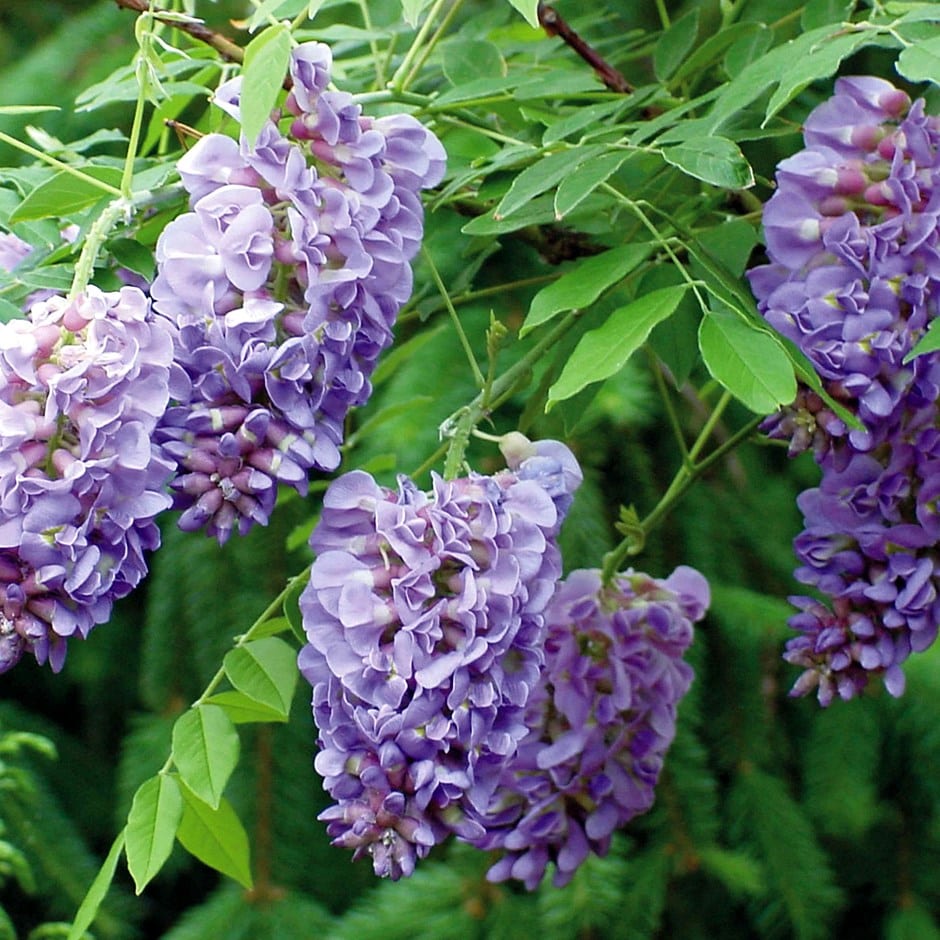Wisteria frutescens 'Amethyst Falls' (PBR)
wisteria




A native species of North America, this is a more compact form than its Chinese and Japanese cousins. This makes it ideally suited for large pots, which can be placed under pergolas or arches to transform them into a charming feature, well-suited to a cottage garden. If the garden is large enough, then plant them out against the wall of a house for an incredible late spring and summer display. Its dense clusters of lilac-blue flowers seem to drip from its twining stems and they emit a delicious fragrance, so make sure you plant it near a seating area or entrance if you can.
This plant has been vegetatively propagated, so will flower earlier than those grown from seed.
To avoid dry conditions, and to ensure good soil contact around the rootball, we advise planting climbers at least 30cm (12in), and preferably 45-60cm (18-24in) away from the base of a wall or fence. An even larger distance should be maintained when planting climbers beside an existing tree or shrub.
To get lots of flowers, the twining stems need pruning twice a year - once in summer (about two months after the flowering has finished) and again in mid-winter. To train your wisteria against a wall, the wall will first need a network of stout horizontal wires, attached at approximately 30cm intervals. After planting, prune the leading shoot of your wisteria back to approximately 90cm above ground level and remove any side branches as this will encourage a strong new leader to form. In the summer of the first growing season, tie the leader in vertically and choose two new lateral shoots on either side of the leader. Tie these onto the wires at a 45 degree angle. Any smaller shoots coming from these lateral branches should be cut back to two or three buds. In the first winter, cut back the leader to a bud approximately 75cm above the highest lateral branch. Gently untie the lateral branches and prune them back by about a third, then re-tie them onto a wire so they are nearly horizontal. In subsequent summers (and until the plant has filled the allotted space), tie in the leader as it grows and choose two strong laterals to form the next tier. These should then be tied in at a 45 degree angle and as in the previous year, any smaller shoots coming from these should be cut back to two or three buds. In subsequent winters cut back the leading shoot as before and cut back and re-tie the new laterals to a near-horizontal position. The older laterals can be cut back by about a third of their total length. Once the plant has become established and reached the desired height, keep tying in the lateral stems as they spread out. In summer, cut back the wispy stems on both the laterals and sub-laterals (the side shoots from the laterals) to about five or six buds from the main branches. In winter, cut back these stems even harder to within two or three buds of the main branches. These form the short spurs that will go on to produce flowers in the following spring.
Full sun
Fast-growing
Moderately fertile, moist, well-drained soil
Fully hardy

Clematis 'Black Prince'
clematis (group 3) (syn. Clematis viticella Black Prince)
Clematis montana var. rubens 'Tetrarose'
clematis (group 1)
| 3 litre pot | 60cm cane | £22.95 |
|
|
| 9cm pot | 30cm cane | £14.99 |
|
|
| 2 + 1 FREE 9cm pots | £29.98 |
|
Get the latest from RHS Plants, including offers and inspiration. Plus - save 10% off your first order when you sign up.
View our Privacy Policy
